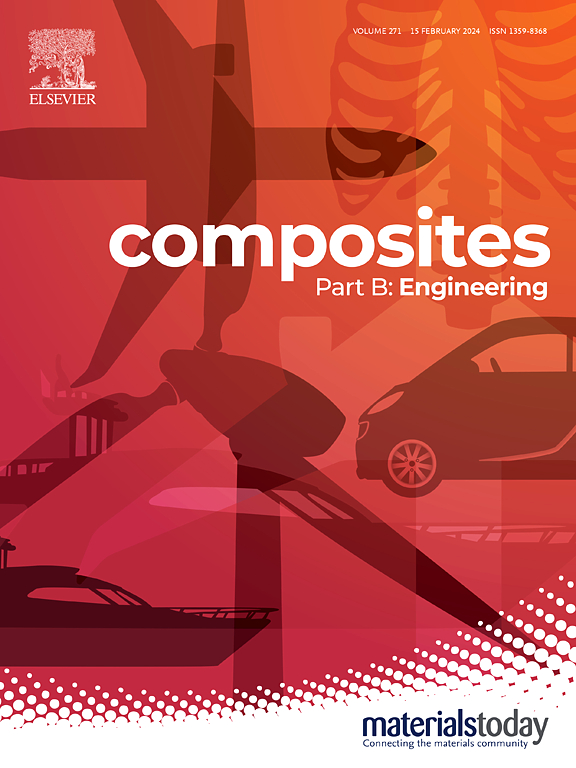Design and fabrication of bionic Bouligand-structured SiC/2024Al composites via binder jetting additive manufacturing and pressure infiltration
IF 12.7
1区 材料科学
Q1 ENGINEERING, MULTIDISCIPLINARY
引用次数: 0
Abstract
Metal matrix composites (MMCs) are widely used in high-end manufacturing. However, the tradeoff between the strength and toughness of these materials poses a problem. In this study, inspired by nature, bionic Bouligand-structured SiC/2024Al composites with a pitch angle in the range of 15°–45° were designed using SolidWorks software and prepared via binder jetting additive manufacturing and pressure infiltration. Their SiC content was about 11.6 vol%, and their porosity ranged from 1.59 % to 2.80 %. A periodic structure was confirmed from microstructural observations and a micro-computed tomography examination. Furthermore, a pitch-angle-related mechanical property was observed in the composites. In particular, finite element analysis showed that the 45°-pitch-angle composite had lower stress concentration and higher load carrying capacity than the composites with other pitch angles. After solution and aging treatment, nano-scale θ′ and S′ phases precipitated in the matrix, resulting in Orowan strengthening behavior. Consequently, the heat-treated 45°-pitch-angle composite showed a higher compressive strength of 741.59 MPa, a compressive strain exceeding 30 % and a KIC value of 13.32 MPa m1/2. The results of this study are expected to contribute to development of methods to overcome the strength-toughness tradeoff problem in MMCs.

基于粘结剂喷射增材制造和压力渗透的仿生bouligand结构SiC/2024Al复合材料的设计与制备
金属基复合材料在高端制造业中有着广泛的应用。然而,这些材料的强度和韧性之间的权衡带来了一个问题。本研究以大自然为灵感,利用SolidWorks软件设计了仰角在15°-45°范围内的仿生bouligand结构SiC/2024Al复合材料,并通过粘结剂喷射增材制造和压力渗透制备了复合材料。SiC含量约为11.6 vol%,孔隙率为1.59% ~ 2.80%。从显微结构观察和显微计算机断层扫描检查中证实了周期性结构。此外,复合材料的力学性能与俯仰角有关。特别是,有限元分析表明,45°俯仰角复合材料比其他俯仰角复合材料具有更低的应力集中和更高的承载能力。固溶时效处理后,纳米级θ′和S′相在基体中析出,形成Orowan强化行为。结果表明,经过热处理的45°俯仰角复合材料抗压强度达到741.59 MPa,抗压应变超过30%,KIC值为13.32 MPa m1/2。本研究的结果有望有助于开发克服mmc中强度-韧性权衡问题的方法。
本文章由计算机程序翻译,如有差异,请以英文原文为准。
求助全文
约1分钟内获得全文
求助全文
来源期刊

Composites Part B: Engineering
工程技术-材料科学:复合
CiteScore
24.40
自引率
11.50%
发文量
784
审稿时长
21 days
期刊介绍:
Composites Part B: Engineering is a journal that publishes impactful research of high quality on composite materials. This research is supported by fundamental mechanics and materials science and engineering approaches. The targeted research can cover a wide range of length scales, ranging from nano to micro and meso, and even to the full product and structure level. The journal specifically focuses on engineering applications that involve high performance composites. These applications can range from low volume and high cost to high volume and low cost composite development.
The main goal of the journal is to provide a platform for the prompt publication of original and high quality research. The emphasis is on design, development, modeling, validation, and manufacturing of engineering details and concepts. The journal welcomes both basic research papers and proposals for review articles. Authors are encouraged to address challenges across various application areas. These areas include, but are not limited to, aerospace, automotive, and other surface transportation. The journal also covers energy-related applications, with a focus on renewable energy. Other application areas include infrastructure, off-shore and maritime projects, health care technology, and recreational products.
 求助内容:
求助内容: 应助结果提醒方式:
应助结果提醒方式:


